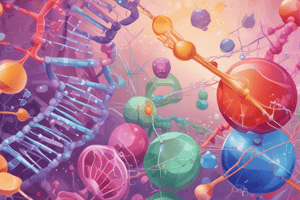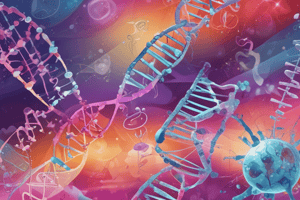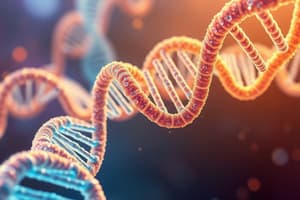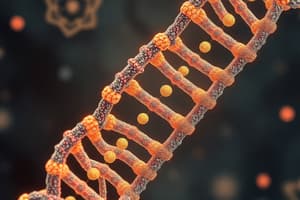Podcast
Questions and Answers
Camptothecin derivatives inhibit topoisomerases by which mechanism?
Camptothecin derivatives inhibit topoisomerases by which mechanism?
- Competitive inhibition of the ATP binding site.
- Causing double-stranded breaks in the DNA.
- Enhancing the rate of cleavage and preventing re-ligation. (correct)
- Inhibiting DNA-topoisomerase binding.
Which of the following is a key distinction between type I and type II topoisomerases concerning their mechanism of action?
Which of the following is a key distinction between type I and type II topoisomerases concerning their mechanism of action?
- Type I topoisomerases cause single-strand breaks, while type II cause double-strand breaks. (correct)
- Type I topoisomerases are not present in tumors, while type II are.
- Type I topoisomerases require ATP hydrolysis, while type II do not.
- Type I topoisomerases cause double-strand breaks, while type II cause single-strand breaks.
Why are topoisomerases considered important targets for chemotherapeutic agents?
Why are topoisomerases considered important targets for chemotherapeutic agents?
- They protect tumor cells from the effects of other chemotherapeutic agents.
- They are generally downregulated in tumor cells, preventing DNA replication.
- They are only present in healthy cells, making them ideal for selective targeting.
- They are generally present at elevated levels in tumors, making them a vulnerable target. (correct)
Novobiocin and coumermycin inhibit Type II topoisomerases, which act through what mechanism?
Novobiocin and coumermycin inhibit Type II topoisomerases, which act through what mechanism?
Which of the following best describes the ‘cleavage complex’ formed by topoisomerase inhibitors?
Which of the following best describes the ‘cleavage complex’ formed by topoisomerase inhibitors?
Which mechanism describes how dexrazoxane inhibits topoisomerase II?
Which mechanism describes how dexrazoxane inhibits topoisomerase II?
What critical function does camptothecin perform in its mechanism of action?
What critical function does camptothecin perform in its mechanism of action?
What limits the clinical use of camptothecin?
What limits the clinical use of camptothecin?
What modification enhances the pharmaceutical properties of camptothecin?
What modification enhances the pharmaceutical properties of camptothecin?
Irinotecan is a prodrug that requires activation to its active form, SN-38. Which enzyme is primarily responsible for this conversion?
Irinotecan is a prodrug that requires activation to its active form, SN-38. Which enzyme is primarily responsible for this conversion?
Irinotecan is used in combination with other drugs for the treatment of colon cancer. Which chemotherapy regimen includes irinotecan?
Irinotecan is used in combination with other drugs for the treatment of colon cancer. Which chemotherapy regimen includes irinotecan?
What is the role of CYP3A4 in irinotecan metabolism?
What is the role of CYP3A4 in irinotecan metabolism?
Which specific type of cancer is Topotecan used to treat?
Which specific type of cancer is Topotecan used to treat?
Camptothecin is derived from which natural source?
Camptothecin is derived from which natural source?
What is the ultimate cellular consequence of the DNA strand breaks caused by camptothecin?
What is the ultimate cellular consequence of the DNA strand breaks caused by camptothecin?
Etoposide works by which of the following mechanisms?
Etoposide works by which of the following mechanisms?
Which of the following describes the primary mechanism of resistance to etoposide?
Which of the following describes the primary mechanism of resistance to etoposide?
What phase of the cell cycle is primarily affected by Etoposide?
What phase of the cell cycle is primarily affected by Etoposide?
Which of the following is a common clinical use of etoposide?
Which of the following is a common clinical use of etoposide?
Vincristine and vinblastine disrupt microtubules by which mechanism?
Vincristine and vinblastine disrupt microtubules by which mechanism?
Why does vincristine commonly cause peripheral neuropathy?
Why does vincristine commonly cause peripheral neuropathy?
How does paclitaxel affect microtubule dynamics?
How does paclitaxel affect microtubule dynamics?
What is the primary mechanism of action of docetaxel?
What is the primary mechanism of action of docetaxel?
Which of the following is a key difference between vinblastine and vincristine in terms of their clinical use and side effects?
Which of the following is a key difference between vinblastine and vincristine in terms of their clinical use and side effects?
What is the source of paclitaxel?
What is the source of paclitaxel?
Which of the following bests describes what a microtubule stabilizer does?
Which of the following bests describes what a microtubule stabilizer does?
What is the mechanism of action of Noscapine?
What is the mechanism of action of Noscapine?
What is the relationship between ABC transporters and drug resistance?
What is the relationship between ABC transporters and drug resistance?
Etoposide is derived from what source?
Etoposide is derived from what source?
Which of the following is NOT an application of Paclitaxel according to the text?
Which of the following is NOT an application of Paclitaxel according to the text?
Flashcards
Topoisomerases
Topoisomerases
Enzymes that manipulate the supercoiling of DNA during replication and transcription.
Type I Topoisomerases
Type I Topoisomerases
Enzymes that create single-strand breaks in DNA, changing its supercoiling without ATP.
Type II Topoisomerases
Type II Topoisomerases
Enzymes that create double-strand breaks in DNA, typically requiring ATP.
Topoisomerase inhibitors
Topoisomerase inhibitors
Signup and view all the flashcards
Topoisomerase poisons
Topoisomerase poisons
Signup and view all the flashcards
Camptothecin
Camptothecin
Signup and view all the flashcards
Ternary complex
Ternary complex
Signup and view all the flashcards
Adverse drug reactions
Adverse drug reactions
Signup and view all the flashcards
Irinotecan
Irinotecan
Signup and view all the flashcards
Topotecan
Topotecan
Signup and view all the flashcards
Prodrug activation
Prodrug activation
Signup and view all the flashcards
CYP3A4 metabolism
CYP3A4 metabolism
Signup and view all the flashcards
UDP glucuronosyltransferase
UDP glucuronosyltransferase
Signup and view all the flashcards
Camptotheca acuminata
Camptotheca acuminata
Signup and view all the flashcards
Downregulated
Downregulated
Signup and view all the flashcards
Upregulated
Upregulated
Signup and view all the flashcards
Etoposide
Etoposide
Signup and view all the flashcards
Topoisomerase II
Topoisomerase II
Signup and view all the flashcards
Myelosuppression
Myelosuppression
Signup and view all the flashcards
Vinca alkaloids
Vinca alkaloids
Signup and view all the flashcards
Paclitaxel
Paclitaxel
Signup and view all the flashcards
Docetaxel
Docetaxel
Signup and view all the flashcards
Microtubules
Microtubules
Signup and view all the flashcards
Antimicrotubular agents
Antimicrotubular agents
Signup and view all the flashcards
Glutathione conjugation
Glutathione conjugation
Signup and view all the flashcards
ABCs
ABCs
Signup and view all the flashcards
Resistance mechanisms
Resistance mechanisms
Signup and view all the flashcards
Cell cycle phases
Cell cycle phases
Signup and view all the flashcards
Study Notes
DNA "Cutters" - Topoisomerases Inhibitors
- Camptothecin and derivatives are inhibitors of DNA topoisomerases
- Anthracyclines are also inhibitors of DNA topoisomerases
- Podophyllotoxin derivatives are DNA topoisomerase inhibitors
DNA Topoisomerases
- Crucial in DNA replication and RNA transcription
- Type I topoisomerases cause single-strand breaks in DNA, changing its supercoiling
- Type II topoisomerases cause double-strand breaks in DNA
- Topoisomerases are often elevated in tumors
Topoisomerase Inhibitors
- Inhibit DNA topoisomerase activity, impacting various cellular processes
- Some inhibitors prevent the re-ligation step of DNA after a break
- Competing for ATP binding stalls DNA hydrolysis
- Inhibiting DNA-topoisomerase binding disrupts the enzymes
- Prevent ATP hydrolysis and DNA release
Camptothecin
- Forms a stable ternary complex with topo I-DNA
- Intercalates between DNA bases
- Causes DNA strand breaks, leading to apoptosis
- Exhibits strong activity in preclinical trials
- Low solubility in water
Camptothecin Analogues
- Structurally modified derivatives of camptothecin
- Irinotecan and Topotecan are notable examples
- Irinotecan is a prodrug that is metabolised to SN-38
- Topotecan primarily used for ovarian and lung cancer
Irinotecan (CPT-11) Metabolism
- Metabolised by CYP3A4 to active SN-38
- Further metabolised to an inactive form via glucoronidation by UGT1A1
- Resistance to Irinotecan can stem from reduced UGT1A1 function which hinders metabolism from SN-38 to its inactive form
- Resistance can also arise due to increased expression of CYP3A4.
Cytochrome P450
- Irinotecan is also inactivated by P450 enzymes (CYP3A4)
Anthracyclines - Mechanism of Action
- Inhibit topoisomerase II, leading to DNA strand breaks
- Intercalates with DNA, causing partial unwinding
- Generates free radicals that damage DNA, and cell membranes
- Important antitumor antibiotics like Doxorubicin and Daunorubicin.
Anthracycline Toxicity
- Myelosuppression (bone marrow suppression)
- Mucositis (oral inflammation)
- Cardiac toxicity, potentially delayed.
- Dexrazoxane can reduce adverse cardiovascular effects and may reduce cardiac toxicity
Resistance to Anthracyclines
- Increased expression of DNA repair enzymes contributes significantly
- Variations in drug efflux transporters can contribute to drug resistance.
Podophyllotoxin Derivatives
- Semi-synthetic glycoside derivatives of podophyllotoxin
- Etoposide and Teniposide are examples
- These accumulate better in cells compared to other compounds
Etoposide (VP-16)
- Non-intercalating topoisomerase II inhibitor
- Forms a stabilized ternary complex with topoisomerase II and DNA
- Leads to single and double-strand DNA breaks
Etoposide - Clinical Use
- Used to treat testicular cancer, lung cancer, acute myeloid leukemia
Etoposide Resistance
- Enhanced efflux of the drug from cells
- Decreased binding to topoisomerase II
- Increased glutathione conjugation
Antimicrotubular Agents
- Vinca alkaloids (Vinblastine, Vincristine) and Taxanes (Paclitaxel, Docetaxel)
- These compounds affect microtubules function hence cell division
- Microtubules are important components of the cytoskeleton; involved in mitosis, cell structure, organelle transport
Vinca Alkaloids
- Vincristine and Vinblastine bind to tubulin
- Destabilize microtubules and inhibit cell division.
Clinical Activity of Vinca Alkaloids
- Vincristine is effective against leukemia, lymphomas and solid tumors
- Vinblastine effective against Hodgkin's Lymphoma and non-small cell lung cancer.
Paclitaxel (Taxol)
- Tubulin stabilizer
- Prevents microtubule depolymerization
- Effective against ovarian, breast, and lung cancers
Docetaxel (Taxotere)
- Tubulin binder with higher affinity compared to paclitaxel
- Effective against ovarian and breast cancers.
Noscapine
- Isoquinoline alkaloid
- Found in opium latex
- Investigational for use in the treatment of prostate cancer.
- Fewer side effects compared to other microtubule disruptors.
Studying That Suits You
Use AI to generate personalized quizzes and flashcards to suit your learning preferences.
Related Documents
Description
Explore DNA topoisomerases and their crucial role in DNA replication and transcription. Learn about different types of topoisomerases and inhibitors like camptothecin and anthracyclines. Understand how these inhibitors disrupt DNA processes, leading to apoptosis.




